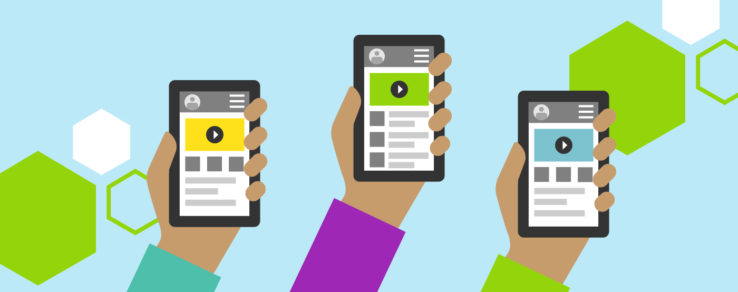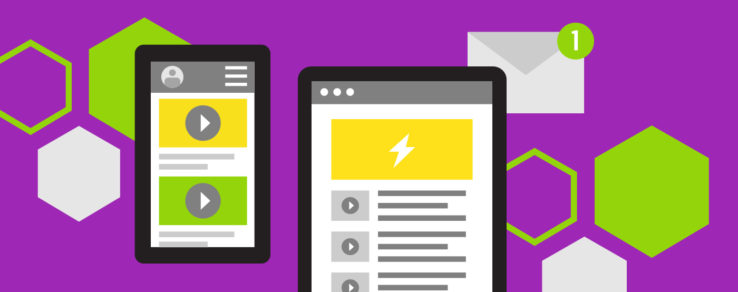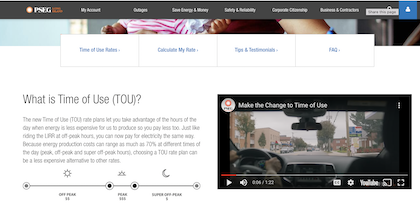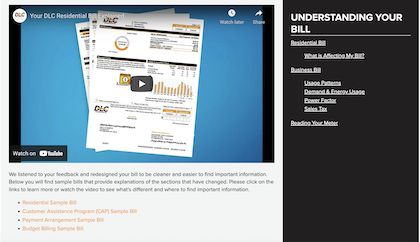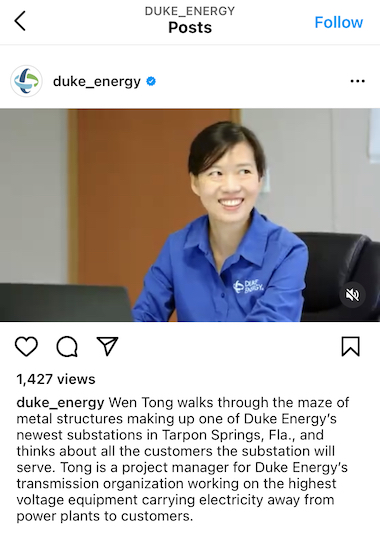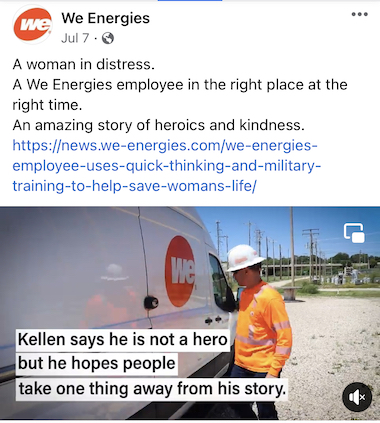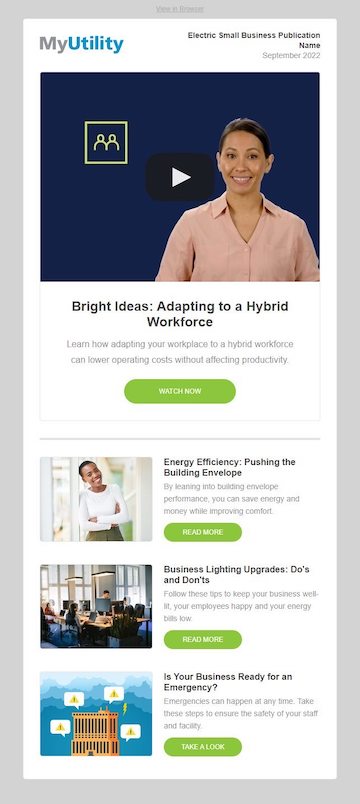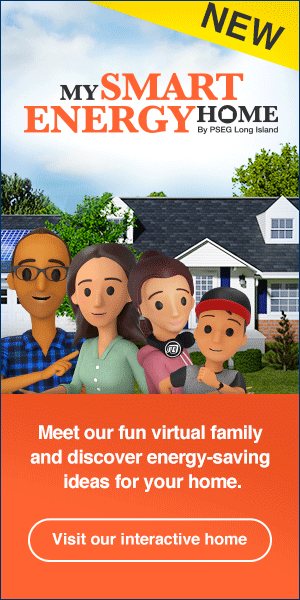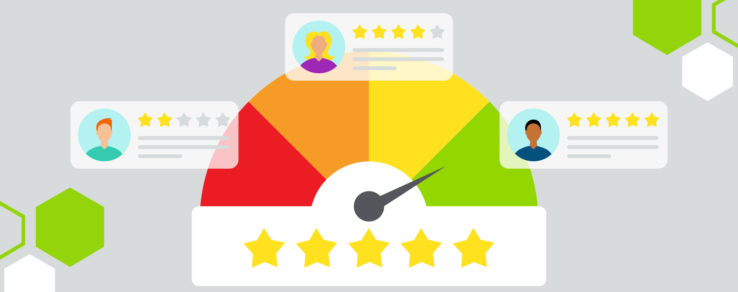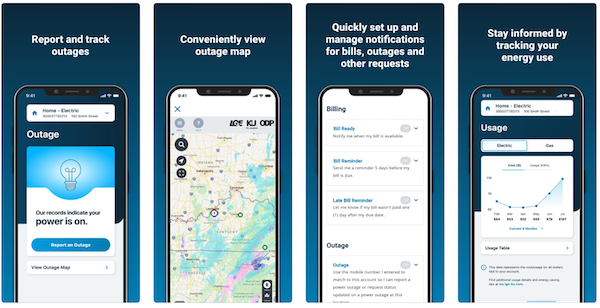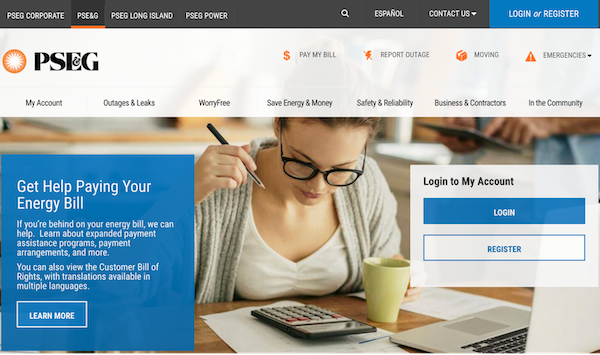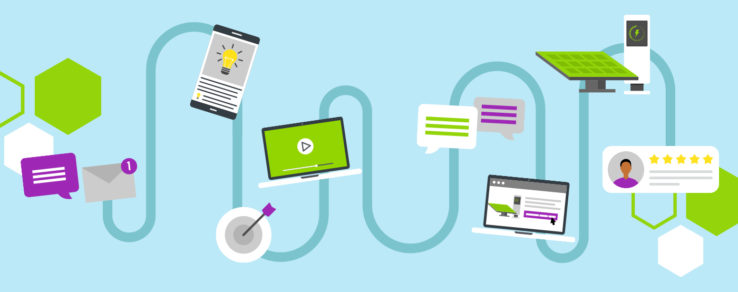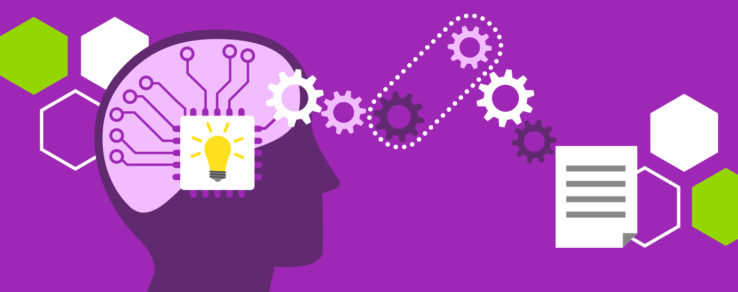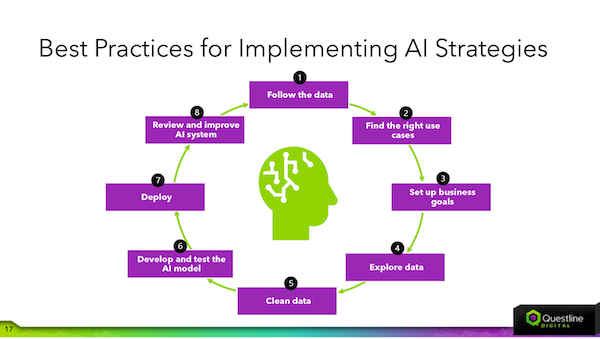Personalized energy customer videos cannot be overlooked as a tool to reach, educate and engage with your customers. Videos play a key role in attracting and capturing attention, as well as delivering information in a fun, easy-to-understand format.
These benefits are magnified for utilities that need to communicate complex program and energy-use information in a way that’s compelling and actionable. Using personalized energy customer videos in your outreach strategy can elevate program promotions, smart home technologies, rate plan communications and more.
Why your energy utility needs personalized energy customer videos:
- Capture and hold customers’ attention
- Entertain and educate customers about complex topics that are relevant to them
- Drive traffic to your utility’s website or program landing pages
- Encourage social media shares and engagement
- Build brand trust and loyalty
The Value of Personalized Energy Customer Videos for Marketing
It’s no secret that videos have been a common way to consume content, whether for entertainment or educational purposes. According to Statista, U.S. adults spend 103 minutes every day watching digital videos on various devices. That’s nearly two hours’ worth of video content consumed per day. Questline Digital’s own performance metrics show that video is consistently one of the most popular formats for educational utility content.
In the current digital landscape, personalization has become increasingly important. Customers now expect unique digital experiences, and a one-size-fits-all approach is no longer effective. More than 98% of marketers say personalization improves customer relationships, and personalized energy customer videos are a perfect way to achieve this.
Why should your utility take advantage of personalized energy customer videos?
Just as consumers are inundated with emails and ads from brands around the world, they are also inundated with video content. That’s why your utility’s video content needs to stand out. Videos should be created with the customer in mind to help them solve a problem, answer a question or otherwise bring value to their daily lives.
Relationship-building emails that include a video can boost click-through rates by 200% to 300%. In addition, including videos in emails has the potential to reduce email unsubscribe rates by 26%.
It’s also important to deliver content that is personalized to each customer. Videos tailored to individuals have a higher click-to-open rate and a unique click-through rate that’s 4.5 times higher.
According to Questline Digital’s Benchmarks Report, the top 10 most popular residential customer videos achieved an impressive nearly 100,000 combined page views. The types of video content marketing included topics that helped customers save money, DIY solutions for energy-efficiency and informational videos on other energy equipment.
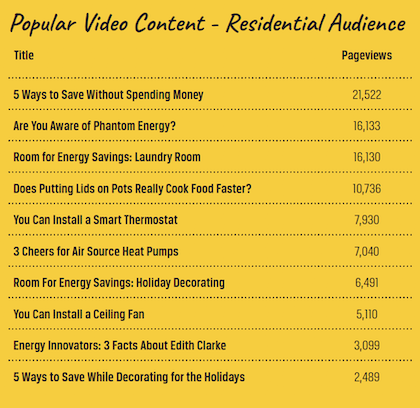
Top Reasons to Use Personalized Energy Customer Videos
Including personalized energy customer videos as part of your utility’s communications plan is a highly effective way to increase customer engagement and satisfaction. Read on to learn the five specific reasons why video content adds value to a marketing strategy.
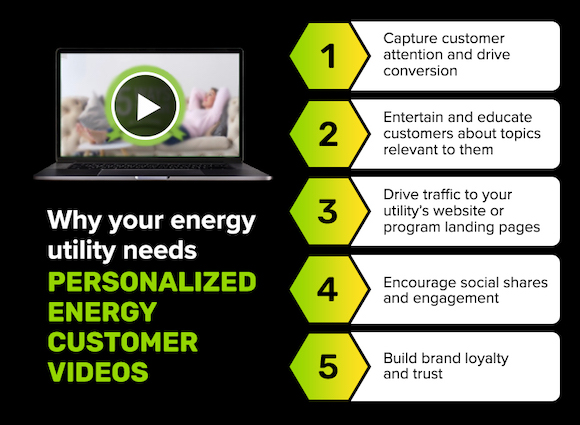
1. Capture customer attention and drive conversion
Customers are bombarded by hundreds of marketing campaigns each day, but a personalized video provides an individualized experience, capturing attention in a unique and powerful way.
Personalized energy customer videos drive higher engagement and more conversions. In fact, a personalized call to action results in 202% more conversions than one that isn’t. Customers like to feel cared about, and they are more likely to engage in content that is tailored specifically for them.
2. Entertain and educate customers about relevant topics
Personalized energy customer videos are especially useful when needing to explain complex topics to utility customers, like demand response programs or new rate plan options. Additionally, it is an easy way to provide relevant videos to each customer. Rather than writing a wordy text article about a time-of-use rate plan, a personalized video can quickly show the impact of the rate plan using the customer’s actual energy use in a relevant example.
The visual elements of a video are also helpful tools to help customers understand how something works, like in the case of a bill redesign. When PSEG Long Island introduced a new bill design to customers, it worked with Questline Digital to develop an engaging and educational video to help customers understand the changes to their monthly bills.
3. Drive traffic to your utility’s website or program landing pages
One key advantage of personalized energy customer videos is their ability to drive traffic to your utility’s website. Personalization not only captures customers’ attention but also positions your utility’s website as a valuable resource for further exploration. Plus, when you include a call-to-action that drives customers to a particular program or service, you’re making the video actionable and directly driving enrollment.
By delivering highly relevant and targeted content, these videos create a compelling reason for customers to visit your website and take action.
4. Encourage social shares and engagement
Whether on social media or a website, customers expect to see video content. In fact, consumers say that videos are their favorite type of content to see on social media. When customers love what they see, they will often share their good experiences with friends and family, expanding the reach of your utility’s audience. After receiving a personalized energy customer video, many customers may want to share their experiences on their own social media, furthering the reach of your utility’s message.
Videos on social media also feature rich storytelling capabilities in an easy-to-digest format, making it well-suited for busy, on-the-go audiences. Make the visuals eye-catching and keep the video to one minute or less. Make sure you add captions to all your videos so that viewers don’t have to turn on the sound when watching.
5. Build brand trust and loyalty
From fun, animated videos to live-action stories, personalized energy customer videos can show off your company’s unique personality and brand voice. In turn, this helps build trust and loyalty among your customers.
Be authentic in your utility’s creation of video content. Consider a video marketing strategy that includes not just products or programs, but content that demonstrates the human side of your utility as well. Interview employees or show behind-the-scenes moments. These human-centric videos are a welcoming sight to customers and help balance your utility’s marketing strategy.
Adding testimonials into your personalized energy customer videos is another great way to not only promote a product or service but to continue showing the human side of your utility. By showing reviews from real-life customers, others will get to know your utility as a trusted source.
Types of Video Content Marketing
Before your utility can jump into video content marketing, it first needs to decide on the purpose and direction of the video. When choosing the type of video content marketing, consider:
- Goals: What is your utility trying to accomplish with this video? To educate or entertain customers, or to explain a program or service?
- Audience: Who is your utility trying to reach with this video? Does it include a range of residential and business customers or one or the other?
- Metrics: What key performance indicators does your utility want to track? Video views or shares?
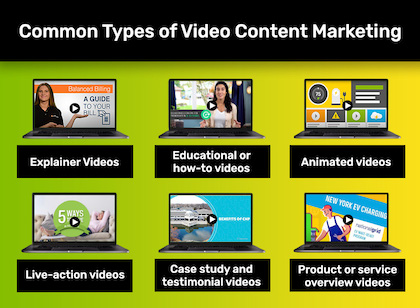
When these questions are answered, it’s time to choose a video format.
Explainer videos
These types of video content marketing help customers more easily understand how your product or service works and why they should purchase or enroll. Many utilities will host explainer videos on their website landing pages or feature them on a homepage of a website.
Key attributes of a good explainer video:
- Short in length, roughly 1 to 2 minutes long
- Includes a strong call-to-action (CTA) that clearly states what a customer should do after watching
- Focuses on a specific challenge and how to overcome it
Educational or how-to videos
Instructional videos help teach something new to your audience. Whether it’s a new industry term you want customers to know or it’s a DIY video about energy efficiency, these types of videos provide value by:
- Encouraging continual learning for customers
- Bringing customers “into the fold” so they understand more about the industry
- Provide customers with the confidence to complete energy-efficient tasks on their own
Animated videos
Animated videos can be a good format for topics that are difficult to grasp and need strong visuals and direction to clearly explain the concept.
Animation can be less expensive and more flexible compared to live-action videos. If changes need to be made, a designer or animator can easily make the changes in the file versus needing to reshoot live video scenes.
Other benefits of animated videos include:
- Easy to demonstrate abstract concepts
- Any idea can be brought to life even if it doesn’t exist in the real world
- Has a longer shelf life and is easier to make edits or updates
Live-action videos
Live-action videos simply mean that the video includes real people versus computer-generated or animated characters. Some benefits of live-action videos include:
- Captures real human emotion and reactions
- Live footage can create an immersive setting for viewers
- Camera and environmental effects, like the sun’s shadow, can more easily be created in real-time versus in animation
Case study and testimonial videos
These types of videos feature real-life, satisfied customers or employees discussing the positive experiences they had with your utility or the products or services that have brought value to their daily lives.
Great testimonial videos often:
- Tell a story from a first-hand perspective
- Are authentic and feature real customers or employees
- Focus on the “why” or the solution that was provided
Product or service overview videos
Often, the best way to promote a program or service to customers is to show them the value it provides. In fact, consumers are four times more likely to watch a video about a product than to read about it. A good product/service overview video should:
- Easily explain a product’s key features and benefits
- Highlight the main components of a product customers should know about
- Provide a clear CTA of what customers should do after watching the video
Video Content Connects with Utility Customers
Personalized energy customer videos are a critical way to engage with customers. Survey results show that 25% of consumers lose interest in a company if they don’t use videos. Don’t let this be your utility. Include different types of video content marketing and personalized energy customer videos to achieve program enrollments and increase customer engagement and satisfaction.
